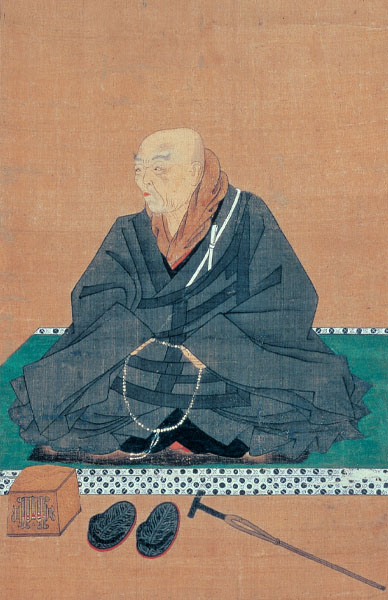Jacket Spine
The
Collected
Works of
SHINRAN
Volume
I

Jōdo Shinshū
Hongwanji-ha
Jacket Cover
The Collected Works of
Shinran
Volume I
The Writings
Spine
The
Collected
Works
of
Shinran
Volume
I
Cover
The Collected Works
of SHINRAN

Half Title
i
THE COLLECTED WORKS OF SHINRAN
Volume I
The Writings
Illustrations
iii

iv

Title
v
The Collected Works of
SHINRAN
Volume I
The Writings
Jōdo Shinshū Hongwanji-ha, KYOTO
SHIN BUDDHISM TRANSLATION SERIES
Series, Translation, Copyright
vi
SHIN BUDDHISM TRANSLATION SERIES
- Letters of Shinran, 1978
- Notes on ‘Essentials of Faith Alone’, 1979
- Notes on Once-calling and Many-calling, 1980
- Notes on the Inscriptions on Sacred Scrolls, 1981
- Passages on the Pure Land Way, 1982
- The True Teaching, Practice, and Realization
- of the Pure Land Way, 1983-1990
- Hymns of the Pure Land, 1991
- Hymns of the Pure Land Masters, 1992
- Hymns of the Dharma-Ages, 1993
- A Record in Lament of Divergences, 1995
- The Collected Works of Shinran, 2 vols., 1997
Translatied, with introductions, glossaries, and reading aids,
by Dennis Hirota (Head Translator), Hisao Inagaki,
Michio Tokunaga, and Ryushin Uryuzu
Copyright © 1997 Jōdo Shinshū Hongwanji-ha
Horikawa-dori, Shimogyo-ku
Kyoto 600 Japan
PRINTED IN THE UNITED STATES OF AMERICA
Preface
vii
Amidst a world undergoing constant and far-reaching change, it is difficult to know what may be taken as the foundation for our lives and how we should carry on our existence. In every age and in all societies, however, it is the true and real teaching that genuinely guides us; nothing else suffices.
Through such writings as the True Teaching, Practice, and Realization of the Pure Land Way, Shinran Shonin clarified the teaching of the Primal Vow of Amida Buddha. This teaching is not restricted in its relevance, but unfailingly becomes meaningful for any person who reflects deeply on human existence. For at heart is the wish to guide all human beings, transcending differences of nationality, ethnicity, and race, to truly fruitful lives. Amida Buddha calls to us, who are inclined to enclose ourselves within our own husks, to awaken to that which is true and real.
The publication of The Collected Works of Shinran is a joyous occasion. The work of translation is difficult, for the understanding required extends to various underlying differences in culture and practices. This work, carried on through the efforts of many persons, is now published in comprehensive form.
It is my hope that, through The Collected Works of Shinran, even one more person may encounter the Shin Buddhist teaching and gain insight into the life of the nembutsu.
Ohtani Koshin
Monshu
Jodo Shinshu Hongwanji-ha
Sokunyo Monshu (Ohtani Koshin, 1945–present),
was the 24th Monshu (1977-2014) of Jodo Shinshu Hongwanji-ha.
Contents
ix
Contents
The Collected Works of Shinran
Volume I
- Preface vii
- List of Illustrations xi
- The Major Expositions
- The True Teaching, Practice, and Realization
of the Pure Land Way
- Preface 3
- Chapter On Teaching 5
- Chapter on Practice 11
- Chapter on Shinjin 75
- Chapter on Realization 151
- Chapter on True Buddha and Land 175
- Chapter on Transformed Buddha-Bodies and Lands 205
- Passages on the Pure Land Way 293
- Hymns in Japanese
- Hymns of the Pure Land 319
- Hymns of the Pure Land Masters 359
- Hymns of the Dharma Ages 395
- Hymns in Praise of Prince Shotoku 431
- Commentaries
- Notes on ‘Essentials of Faith Alone’ 449
- Notes on Once-Calling and Many-Calling 471
- Notes on the Inscriptions of Sacred Scrolls 491
x
- Letters
- Lamp for the Latter Ages 521
- A Collection of Letters 557
- A Collection of Letters (Zenshō Text) 573
- Letters of the Tradition 575
- Uncollected Letters 579
- Shorter Works
- Gutoku’s Notes 585
- Hymn of the Two Gateways of Entrance and Emergence 621
- Passages on the Two Aspects of the Tathagata’s
Directing of Virtue 631 - A Collection of Passages on the Types of Birth
in the Three Pure Land Sutras 637 - The Virtue of the Name of Amida Tathagata 653
- Appendix: Related Works by Other Authors
- A Record in Lament of Divergences 659
- Essentials of Faith Alone 683
- Clarification of Once-Calling and Many-Calling 699
List of Illustrations
xi
Altar scroll with the six-character Name (p. iii)
This scroll, entirely in Shinran’s hand, bears the six Chinese characters for the Name, Na-mu-a-mi-da-butsu, with inscriptions from the Larger Sutra written on separate pieces of paper mounted above and below. At the top is the Eighteenth Vow and the Eleventh Vow; below is the passage appearing on p. 495. The upper inscription carries a colophon: “Gutoku Shinran, with reverence and trust for the Sacred Name; written at age 84.” The lower inscription is dated, “Written on the tenth month, 28th day, first year of Kogen (1256), year fire/dragon.”
Nishi Hongwanji, Kyoto; paper, 28.8 x 87 cm.
Portrait of Shinran (p. iv)
Shinran’s likeness at age 83, about the time he wrote Notes on the Inscriptions on Sacred Scrolls. The original, known as the Anjo portrait (Anjo no go-ei), was given to Shinran’s disciple Senkai of Anjo city in Mikawa province (Aichi prefecture). From a later diary entry, we know it was originally dated Kencho 7 (1255) and carried an attribution to the painter Hogen Choen.
The portrait depicts Shinran as he appeared in daily life, with nenju (rosary) in hand. He is seated on an animal pelt, barely visible in the painting, but reminiscent of wandering monks (hijiri) who traveled from place to place spreading the teaching, for they often attached such skins over their robes so that they could seat themselves anywhere to preach. At Shinran’s right is a wooden brazier used to warm the hands; along with the catskin sandals, it indicates the season. At his left is a cane. Although sandals also appear in the portraits of Honen, the general use of homely details from ordinary life in this painting is a distinctive characteristic of Shin Buddhist portraiture.
Shinran himself wrote the inscriptions for the original portrait. Immediately above the three passages from the Larger Sutra (see pp.
xii
493, 494, and 495) and the top are two passages from the verse portion of Vasubandhu’s Treatise on the Pure Land (see p. 500). Below is a passage from Shinran’s Hymn of the True Shinjin (see pp. 517-518), signed, “Gutoku Shinran, at age 83.”
The original portrait, although repaired twice by Rennyo in 1461 and 1480, is now in poor condition. Fortunately, however, during one of its restorations an excellent copy the size of the original was made. It is this Muromachi period copy that is shown here. Both the original and the copy have been designated National Treasures.
Nishi Hongwanji, Kyoto; silk, 40.1 x 127.6 cm.
Prefatory Notes
PREFATORY NOTES
- In the transliteration of the Sanskrit terms, diacritical marks have in general not been indicated for words not widely used in English (nirvana, prajna, paramita, etc.) or for common nouns; they are indicated, however, for names and proper nouns.
- Translations of identical passages quoted by Shinran occasionally differ slightly to indicate his interpretation in the particular context.
- In notes, the abbreviation SSZ indicates Shinshū shōgyō zensho, (Kyoto: Ōyagi Kōbundō, 1941), and T indicates Taishō shinshū daizōkyō.
- Introductions, glossaries with original terms, and finding lists keyed to original texts are included in Volume II.